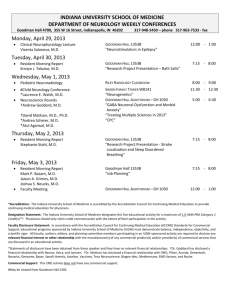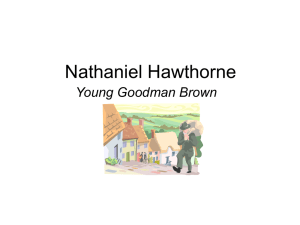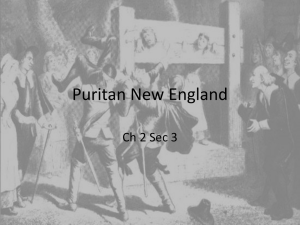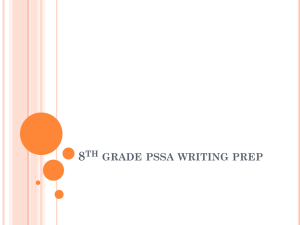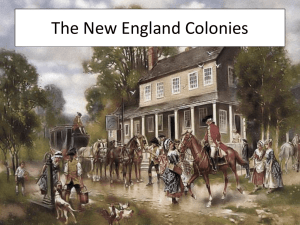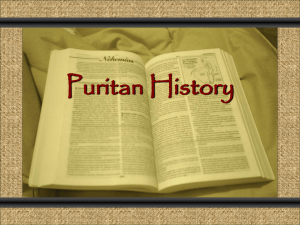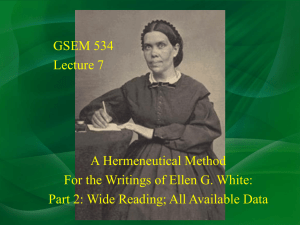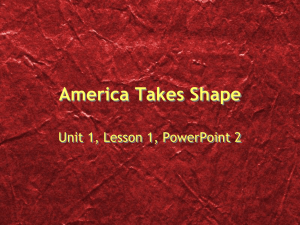Young Goodman Brown
advertisement
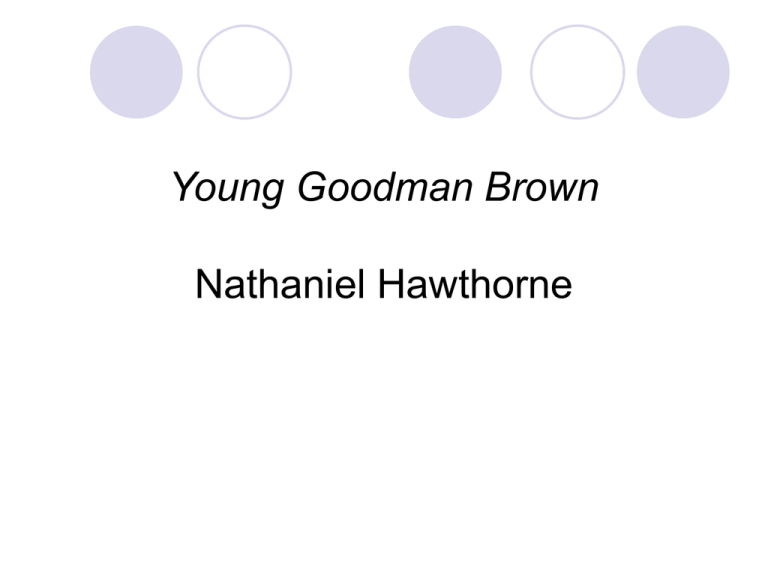
Young Goodman Brown Nathaniel Hawthorne Think-Aloud Predictions for Young Goodman Brown “Young Goodman Brown came forth, at sunset, into the street of Salem Village, but put his head back, after crossing the threshold, to exchange a parting kiss with his young wife.” allegory A poem, play, picture, etc, in which the apparent meaning of the characters and events is used to symbolize a deeper moral or spiritual meaning A story that has a deeper or more general meaning in addition to its surface meaning. Allegories are composed of several symbols or metaphors. For example, in The Pilgrim's Progress, by John Bunyan, the character named Christian struggles to escape from a bog or swamp. The story of his difficulty is a symbol of the difficulty of leading a good life in the “bog” of this world. The “bog” is a metaphor or symbol of life's hardships and distractions. Similarly, when Christian loses a heavy pack that he has been carrying on his back, this symbolizes his freedom from the weight of sin that he has been carrying. Symbol: Word/object that stands for another word/object. Obvious examples are flags, which symbolize a nation; the cross is a symbol for Christianity; Uncle Sam a symbol for the United States. In literature, a symbol is expected to have significance. Primordial Symbols Psychologist Carl Gustav Jung (1875-1961) theorized that all humans share certain inborn impulses and concepts residing in the mind at the unconscious level. For example, all humans react to sunlight in the same way, perceiving it as a symbol of joy, happiness, glory, optimism, truth, a new beginning, or God. Likewise, humans associate dark forests (like the one in "Young Goodman Brown") with danger, obscurity, confusion, and the unknown or with evil, sin, and death. Jung termed external stimuli (such as dark forests) primordial symbols— primordial meaning existing from the beginning of time. Themes How the Puritans’ strict moral code and overemphasis on the sinfulness of humankind foster undue suspicion and distrust. The realization that evil can infect people who seem upright. One man’s virtue is another man’s sin, and vice versa. Puritanism and the Witch Trials Puritanism began in England in the late Sixteenth Century when Protestant reformers attempted to purge the Church of England (or Anglican Church) of the elaborate ceremonies, rituals, and hierarchical structure it retained from the Roman Catholic Church. For the Puritans, the pure word of the Bible, presented in part through inspired preaching, took precedence over rituals while direct revelation from the Holy Spirit superseded reason. After Queen Elizabeth I died in 1603, the Puritans petitioned the new monarch, King James I, to adopt their reforms. In January 1604 at a special conference at Hampton Court Palace near London, the king rejected most of the proposed Puritan reforms but he did grant a Puritan request for a new translation of the Bible, which resulted in publication of the King James Version in 1611. Many disenchanted puritans left the country. Many Puritans emigrated to America and established their brand of religion in Massachusetts and other colonies. Puritan ministers were generally well educated, and Puritan congregations promoted ideals that helped lay the foundation for American democracy. However, because of their strict moral code, the Puritans were ever on the lookout for satanic influence and, unfortunately, sometimes saw evil where none existed. In Salem, Massachusetts in 1692, more than 150 people were accused of witchcraft and jailed. Twenty of them were executed. Nineteen were hanged and one was pressed to death. In a pressing, the executioners secured the condemned person, facing upward, on a bed of nails. Then they loaded weights onto his or her body. American dramatist Arthur Miller wrote a play, The Crucible, about these trials. Belief in evil forces such as witches, warlocks, and diabolical spirits was widespread in America and Europe during and before the 17th Century. Although "Young Goodman Brown" is a fictional tale, it is based on the atmosphere prevailing in Salem, Mass., during the time of the witch trials. . .. Allusions, Historical References, and Vocabulary anathema (paragraph 32): thing or person deemed to be damned or cursed. cinque-foil (paragraph 32): Cinquefoil, a flowering plant of the rose family that has white, red, or yellow petals. Egyptian Magi (paragraph 36): See staff. e'en go thy ways (paragraph 25): Just (righteous) be thy ways. Goodman: Husband or master of a household. Goody: (1) Housewife, especially an elderly one, of a lower class; (2) any lower-class woman; (3) housewife or mistress of a household. King William (paragraph 13): William III, king of England from 1689 to 1702. King Philip (paragraph 18): Nickname of the Wampanoag Indian chief Metacom (or Metacomet). Maltreatment of Indians by whites provoked him into waging what came to be known as King Philip's War against New Englanders in 1675-1676. His defiance instilled fear in the white inhabitants of New England. lecture-day (paragraph 21): Weekday on which a sermon was given. proselyte (paragraph 60): person who converted from one belief or religion to another. staff (paragraph 36): The narrator says, "So saying, he threw it [the staff] down at her feet, where, perhaps, it assumed life, being one of the rods which its owner had formerly lent to the Egyptian magi." This passage alludes to verses 8-12 in Chapter 7 of the Bible's Book of Exodus. According to these verses, God directs Moses to tell Aaron, his brother, to cast down his staff before the throne of the pharaoh of Egypt. When he does so, it transforms itself into a serpent. The pharaoh's magicians (magi) then cast down their staffs, which in like manner turned into serpents. However, Aaron's staff consumes the staffs of the magicians. wolf's-bane (paragraph 32): Wolfsbane, a poisonous plant. wot'st: (paragraph 15): Know. zenith: The point of the celestial sphere (what appears to be the surface of the sky or heavens) that is directly above an observer's head. Figures of Speech Alliteration Repetition of a consonant sound It was now deep dusk in the forest, and deepest in that part of it where these two were journeying. Anaphora Repetition of a word, phrase, or clause in successive groups of words A stern, a sad, a darkly meditative, a distrustful, if not a desperate man, did he become, from the night of that fearful dream. Metaphor Comparison a thing to an unlike thing without using like, as, or than "Then Goody Cloyse knows her old friend?" observed the traveller, confronting her, and leaning on his writhing stick. Onomatopoeia Using a Word to Imitate a Sound the creaking of the trees, the howling of wild beasts Simile Comparison a thing to an unlike thing without using like, as, or than sometimes the wind tolled like a distant church-bell Comparison of the sound of the wind to the sound of a church bell Discussion Questions: 1.Discuss situations and circumstances that cause people in today’s society to enter a “dark forest,” as Goodman Brown did. 2.Does Goodman Brown really attend a witches' sabbath or does he dream about it? 5.Why does Goodman Brown become "a stern, a sad, a darkly meditative, a distrustful, if not a desperate man" after his experience in the forest? 5.Why are people today fascinated with stories about witchcraft, sorcery, and magic? 6.After Goodman Brown returns from the forest, he becomes a cynical man. Does he see evil where there is goodness? Identify “witch hunts” that are occurring today in your community or your country? For example, are people on one side of an issue attempting to discredit people on the other side of the issue by using unfair tactics that impugn the latter's reputation?
